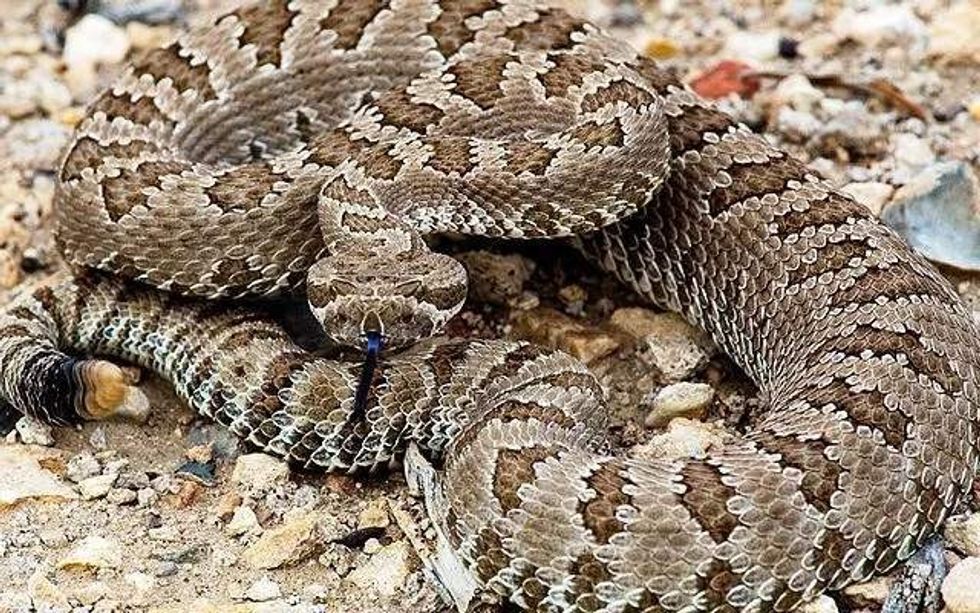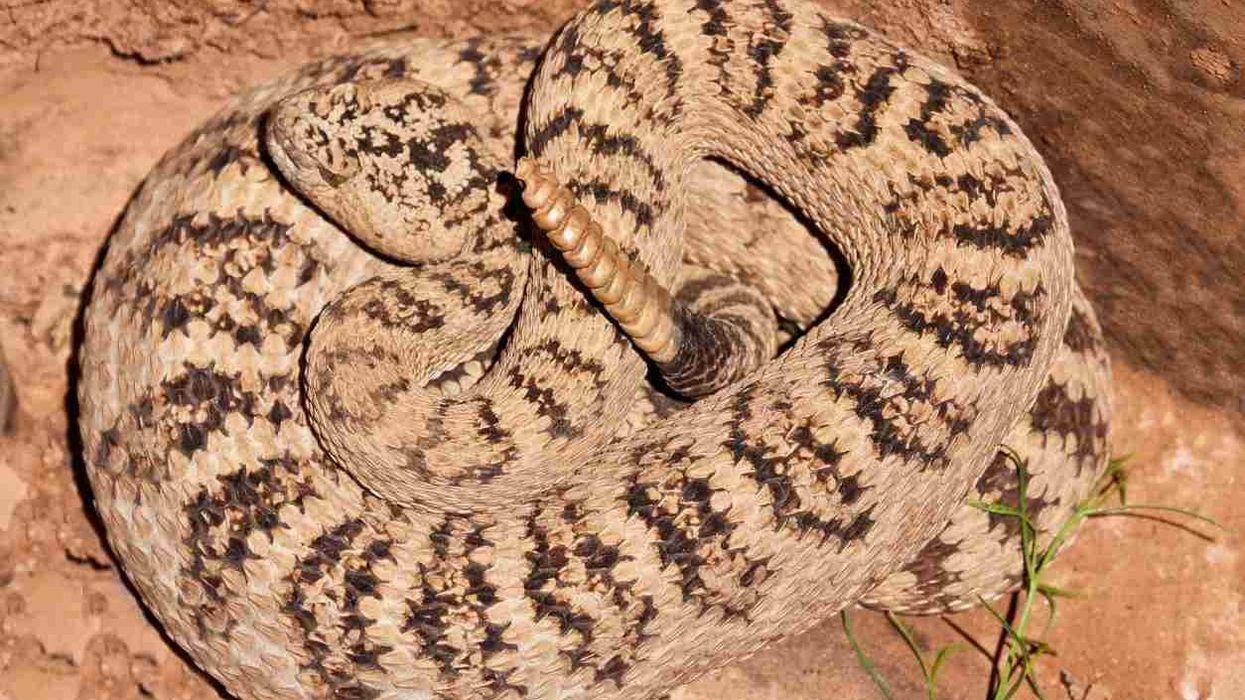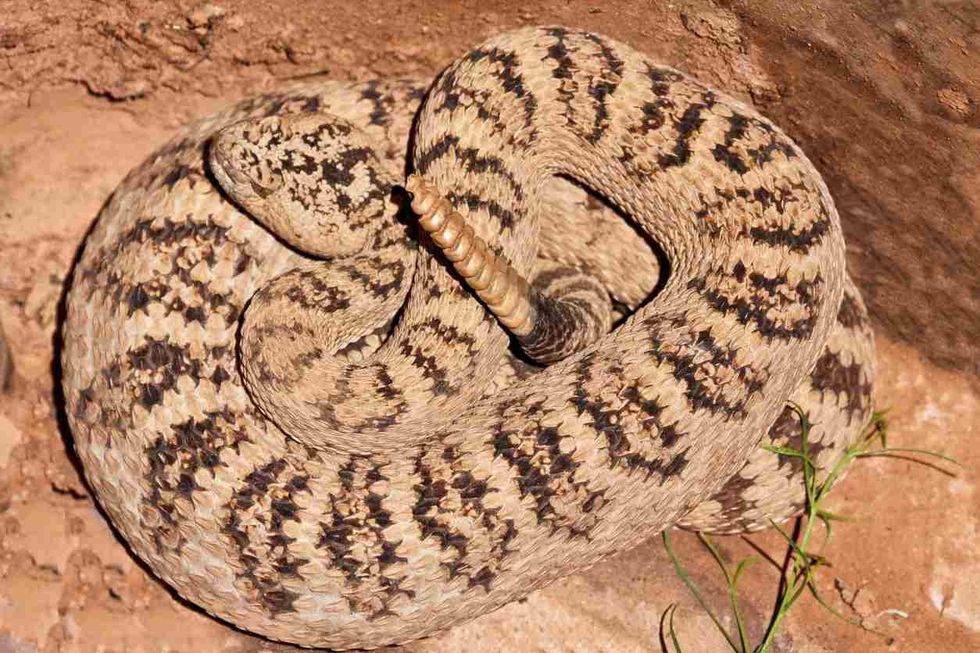Fun Great Basin Rattlesnake Facts For Kids

Great Basin Rattlesnakes are heavy-bodied snakes that are a subspecies of the rattlesnake family, they are medium-sized with a triangular-shaped head and rattles on their tail. A white stripe is visible from behind the eyes to each corner of the mouth. These species are found in southern Oregon, northern California, southern Idaho, Arizona, Utah, and Nevada.
The Great Basin Rattlesnakes have adjustable fangs that are connected by their sharp and curvy venom ducts that can be found at the edge of their upper jaw. These species are always at risk of death or harm as they are often seen as dangerous.
The great basin rattlesnakes are venomous pit viper species that have a heat sensory pit organ between the eyes and the nostrils of their triangular head, with blotches all over their body from head to tail with dark color patterns.
If you like these facts about Great Basin Rattlesnake, then you'll surely like these facts about the rattlesnake and eastern diamondback rattlesnake too.
Great Basin Rattlesnake Interesting Facts
What type of animal is a Great Basin Rattlesnake?
The Great Basin Rattlesnake (Crotalus oreganus lutosus) is medium-sized compared to the other subspecies of rattlesnakes. They are pit vipers and can be found in the Great Basin Region of the United States.
There are more than 60-75 subspecies among the 36 known rattlesnake species, with the majority of species found in Arizona, Texas, southern Idaho, Western Utah, California, and Nevada.
What class of animal does a Great Basin Rattlesnake belong to?
The Great Basin Rattlesnake (Crotalus oreganus lutosus) belongs to the Reptilia family; reptiles are tetrapod vertebrates, i.e. creatures that have either four limbs or like snakes. Most reptiles produce young using eggs which are hatched after they have been laid by the parent, as in birds. The reptile class comprises tortoises, turtles, snakes, lizards, crocodilians, and other relatives.
How many Great Basin Rattlesnakes are there in the world?
Currently, there is no estimated count of the population of the Great Basin Rattlesnake species in the world.
Where does a Great Basin Rattlesnake live?
The Great Basin Rattlesnake (Crotalus oreganus lutosus) as the name suggests is found in the Great Basin regions of the United States. The great basin rattlesnake ranges from western Utah, Arizona, Colorado, Nevada, Idaho, Grand Canyon, California, and Oregon.
What is a Great Basin Rattlesnake's habitat?
The Great Basin Rattlesnake is found nesting on hills, old lake benches, summits, and rocky slopes. These species prefer exposure to big boulders and rocky regions on hillsides, mountainsides, valley floors, and open deserts.
Who do Great Basin Rattlesnakes live with?
The Great Basin Rattlesnakes are solitary animals just like most other snake species. However, in some cases, they often share resting spaces with other rattlesnakes of the same species, mostly the young. They are lone hunters in the wild.
How long does a Great Basin Rattlesnake live?
The natural lifespan of the Great Basin Rattlesnake species in the wild is 15-20 years. In captivity, however, they are known to live around 25 years!
How do they reproduce?
The Great Basin Rattlesnake (scientific name Crotalus oreganus lutosus) mates during the spring season after coming out of hibernation.
Adult males are more active than females who are extremely passive during the mating process, males will press their tails beneath their partners, and in return, the female lifts her tail and in this process, the cloacas come in contact impregnating the females.
The great basin rattlesnake gestation period lasts for 167 days, as these species are viviparous, implying the snake gives birth to live young ones.
What is their conservation status?
As per IUCN, the Great Basin Rattlesnakes are listed as a species of Least Concern due to the vast availability of these species in the United States. The conservation status of these species may change in the future due to the disappearance of their natural habitat.
Great Basin Rattlesnake Fun Facts
What do Great Basin Rattlesnakes look like?

The Great Basin Rattlesnakes have a color pattern consisting of pale gray, olive-brown, pale brown, and yellowish-brown ground color, buff with a series of 32-49 dorsal blotches and a slim body. The Great Basin Rattlesnakes' blotches are black and dark brown, with pale borders and centers with irregular and wider shapes.
The Great Basin Rattlesnakes have cat-like pupils and diamond-shaped eyes.
Great Basin Rattlesnakes are dangerous as they are venomous.
They have venom glands in the upper jaw just near the outer edge, which is located toward the rear of their head, which is accompanied by a ridge nose, in the case of the ridge-nosed rattlesnake.
The skin of these species is covered with scales as they belong to the Reptilia genus. They have rattles on their tails, which are made up of keratin, and are composed of hollow, interlocked keratin segments, created by modifying scales that cover the tip of their tail.
Rattles usually break off due to the day-to-day activities of the rattlesnakes, and hence, the rattles on their tails are not related to the age of a rattlesnake.
The Great Basin Rattlesnakes are pit vipers so they have a heat-sensing pit that is located behind each of their nostrils. This helps them in detecting temperature and heat given off by animals that help them determine prey from a predator.
How cute are they?
Snakelets are super cute! Adult rattlesnakes, not so much!
Baby Great Basin Rattlesnakes might look cute but that does not mean they aren't dangerous! These species are born with venom and even a baby can inject you with it if it bites you. Adult Great Basin Rattlesnakes look outright scary and dangerous, with their scary-looking fangs and a deadly strike, as rattlesnake bites can cause paralysis.
How do they communicate?
As is common with most snake species, the Great Basin Rattlesnakes too communicate through chemicals by releasing pheromones. These species are lipid in nature and communication occurs by leaving traces of, collecting, and analyzing pheromones. They also communicate their age, condition of reproduction, and gender with other snakes that are around them.
How big is a Great Basin Rattlesnake?
Adult Great Basin Rattlesnakes 26-48 in (66-121 cm) in length, and only a few exceed 39.3 in (100 cm). A Great Basin female Rattlesnake size is slightly smaller than males.
How fast can a Great Basin Rattlesnake move?
As of now, there is not much data on the Great Basin Rattlesnake species' movement speed, however, it is on record that the Sidewinder (Crotalus cerastes), can reach speeds up to 18 mph (29 kph).
How much does a Great Basin Rattlesnake weigh?
No accurate data is available on the weight of the Great Basin Rattlesnakes.
What are the male and female names of the species?
The Great Basin Rattlesnakes are simply known as males or females as no particular name has been assigned to either gender. Though, it is easier to differentiate males as they are slightly bigger in length.
What would you call a baby Great Basin Rattlesnake?
No particular name is assigned to baby Great Basin Rattlesnakes, however, baby snakes are called snakelets, newly-born are called neonates, and newly hatched are called hatchlings. After birth, the hatchlings stay with their mother for a couple of hours or a day.
They then scatter in search of food. A rattlesnake baby is born with a 'pre-button' which it loses when it sheds its skin for the first time.
What do they eat?
The Great Basin Rattlesnake diet consists of lizards, rodents, small mammals, birds, reptiles, and amphibians. Juveniles prefer lizards while adults prefer large rodents and birds. While rare, the Great Basin Rattlesnakes are one of the few species known to eat eggs. These species wait and strike their prey while hiding among the leaves littering on the ground.
Are they venomous?
The Great Basin Rattlesnakes are venomous! Their bites can be dangerous, but it's rarely fatal.
However, if the bite is left untreated, it can cause medical issues or can become fatal. The Great Basin Rattlesnake venom can cause damage to your tissue and affect your circulatory system by killing skin tissue and blood cells, which might result in internal hemorrhage.
Even a juvenile Great Basin Rattlesnake bite can be venomous enough to be fatal if not treated properly.
The Great Basin Rattlesnake bite treatment starts with remaining calm and less physical exertion. Since their venom is potentially deadly, anti-venom should be provided within two hours. Polyvalent antivenom can easily neutralize the Great Basin Rattlesnake bite venom.
Would they make a good pet?
The Great Basin Rattlesnakes are often seen as aggressive snake species, so keeping them as pets can be a handful! They can be kept as pets if a good habitat with a rocky region is provided for them to thrive in and a diet consisting of birds, lizards, snakes, smaller reptiles, and amphibians.
However, in certain states, like Arizona, it is illegal to keep them as pets. To get a rattlesnake pet, you have to check with your local exotic pet stores.
Did you know...
The Great Basin Rattlesnakes are found hibernating in dens and under big rocky regions, during the winter when they are hibernating. Males and a few females scatter in the surrounding areas for hunting prey such as mice, squirrels, birds, lizards, snakes, rats, and gophers.
These species can move up to 2.5 mi in search of prey, waiting and attaching the small mammals with patience.
The history of the western rattlesnake taxonomy is complicated. Earlier, there were seven other Crotalus viridis subspecies which were Crotalus viridis abyssus, Crotalus viridis oreganus, Crotalus viridis caliginis, Crotalus viridis lutosus, Crotalus viridis concolor, Crotalus viridis cerberus, and Crotalus viridis helleri.
The western rattlesnake also known as western diamondback rattlesnake bites are the most dangerous and fatal when compared to other subspecies of rattlesnake in the region.
At what elevation is the Great Basin Rattlesnake found?
The Great Basin Rattlesnakes taxonomy is similar to seven other subspecies and occurs at 11,000 ft in elevation, commonly available below 8,000 ft, with a favorable habitat consisting of sagebrush, greasewood, and spruce.
How to tell the difference between a Mojave Rattlesnake and a Great Basin Rattlesnake
The Mojave Rattlesnake (Crotalus viridis lutosus) has a similar appearance to the western diamondback, with a diamond pattern on the back and striped tails. The Mojave Rattlesnakes are greener in color, with black spotting and white tail stripes.
Whereas the Great Basin Rattlesnakes have color patterns consisting of pale gray, olive-brown, and yellowish-brown ground color with an irregular pattern and wider shapes.
Adult Mojave Rattlesnakes (Crotalus viridis lutosus) can grow up to 24-48 in (60.9-121.9 cm) in total length whereas an adult Great Basin Rattlesnake (Crotalus oreganus lutosus) can grow up to 16-64 in (40.6-162.6 cm) in length.
Here at Kidadl, we have carefully created lots of interesting family-friendly animal facts for everyone to discover! Learn more about some other reptiles from our timber rattlesnake fun facts, and prairie rattlesnake surprising facts pages.
You can even occupy yourself at home by coloring in one of our free printable baby rattlesnake coloring pages.
We Want Your Photos!
More for You
Bachelor of Arts specializing in Journalism and Mass Communication, Postgraduate Diploma in Sports Management

Moumita DuttaBachelor of Arts specializing in Journalism and Mass Communication, Postgraduate Diploma in Sports Management
A content writer and editor with a passion for sports, Moumita has honed her skills in producing compelling match reports and stories about sporting heroes. She holds a degree in Journalism and Mass Communication from the Indian Institute of Social Welfare and Business Management, Calcutta University, alongside a postgraduate diploma in Sports Management.
Bachelor of Technology specializing in Computer Science Engineering

Shray SharmaBachelor of Technology specializing in Computer Science Engineering
As an aspiring web and app developer, Shray has a passion for working with promising startups. He is currently pursuing a Bachelor's degree in Computer Science from Maharaja Surajmal Institute Of Technology while gaining experience in digital marketing. Shray has already earned a Google Analytics Certification and is well-equipped to handle analytics and data management tasks. He has also served as a marketing manager at Parallax Virtual Arts, where he oversaw the company's social media, content, and SEO strategies. Shray's goal is to create engaging content that resonates with audiences and offers valuable insights.
Disclaimer
1) Kidadl is independent and to make our service free to you the reader we are supported by advertising. We hope you love our recommendations for products and services! What we suggest is selected independently by the Kidadl team. If you purchase using the Buy Now button we may earn a small commission. This does not influence our choices. Prices are correct and items are available at the time the article was published but we cannot guarantee that on the time of reading. Please note that Kidadl is a participant in the Amazon Services LLC Associates Program, an affiliate advertising program designed to provide a means for sites to earn advertising fees by advertising and linking to Amazon. We also link to other websites, but are not responsible for their content.
2) At Kidadl, we strive to recommend the very best activities and events. We will always aim to give you accurate information at the date of publication - however, information does change, so it’s important you do your own research, double-check and make the decision that is right for your family. We recognise that not all activities and ideas are appropriate for all children and families or in all circumstances. Our recommended activities are based on age but these are a guide. We recommend that these ideas are used as inspiration, that ideas are undertaken with appropriate adult supervision, and that each adult uses their own discretion and knowledge of their children to consider the safety and suitability. Kidadl cannot accept liability for the execution of these ideas, and parental supervision is advised at all times, as safety is paramount. Anyone using the information provided by Kidadl does so at their own risk and we can not accept liability if things go wrong.
3) Because we are an educational resource, we have quotes and facts about a range of historical and modern figures. We do not endorse the actions of or rhetoric of all the people included in these collections, but we think they are important for growing minds to learn about under the guidance of parents or guardians.







